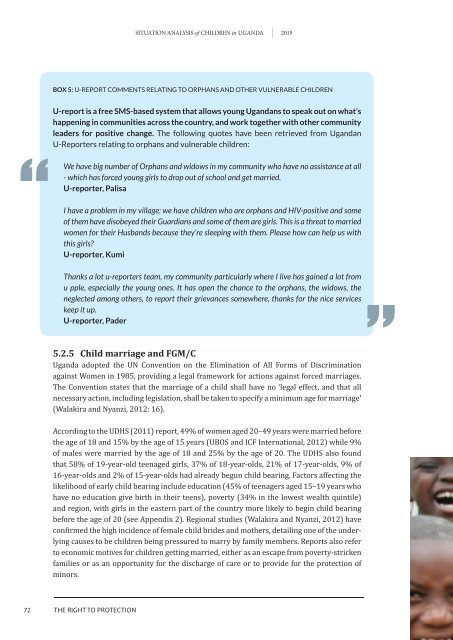Situation analySiS
1TNu802
1TNu802
You also want an ePaper? Increase the reach of your titles
YUMPU automatically turns print PDFs into web optimized ePapers that Google loves.
<strong>Situation</strong> <strong>analySiS</strong> of Children in uganda 2015BOx 5: u-report comments relAtinG to orphAns And other vulnerAble childrenU-report is a free SMS-based system that allows young Ugandans to speak out on what’shappening in communities across the country, and work together with other communityleaders for positive change. the following quotes have been retrieved from ugandanu-reporters relating to orphans and vulnerable children:We have big number of Orphans and widows in my community who have no assistance at all- which has forced young girls to drop out of school and get married.U-reporter, PalisaI have a problem in my village: we have children who are orphans and HIV-positive and someof them have disobeyed their Guardians and some of them are girls. This is a threat to marriedwomen for their Husbands because they’re sleeping with them. Please how can help us withthis girls?U-reporter, KumiThanks a lot u-reporters team, my community particularly where I live has gained a lot fromu pple, especially the young ones. It has open the chance to the orphans, the widows, theneglected among others, to report their grievances somewhere, thanks for the nice serviceskeep it up.U-reporter, Pader5.2.5 Child marriage and FGM/CUganda adopted the UN Convention on the Elimination of All Forms of Discriminationagainst Women in 1985, providing a legal framework for actions against forced marriages.The Convention states that the marriage of a child shall have no ‘legal effect, and that allnecessary action, including legislation, shall be taken to specify a minimum age for marriage’(Walakira and Nyanzi, 2012: 16).According to the UDHS (2011) report, 49% of women aged 20–49 years were married beforethe age of 18 and 15% by the age of 15 years (UBOS and ICF International, 2012) while 9%of males were married by the age of 18 and 25% by the age of 20. The UDHS also foundthat 58% of 19-year-old teenaged girls, 37% of 18-year-olds, 21% of 17-year-olds, 9% of16-year-olds and 2% of 15-year-olds had already begun child bearing. Factors affecting thelikelihood of early child bearing include education (45% of teenagers aged 15–19 years whohave no education give birth in their teens), poverty (34% in the lowest wealth quintile)and region, with girls in the eastern part of the country more likely to begin child bearingbefore the age of 20 (see Appendix 2). Regional studies (Walakira and Nyanzi, 2012) haveconfirmed the high incidence of female child brides and mothers, detailing one of the underlyingcauses to be children being pressured to marry by family members. Reports also referto economic motives for children getting married, either as an escape from poverty-strickenfamilies or as an opportunity for the discharge of care or to provide for the protection ofminors.72 thE rIGht to ProtECtIoN




